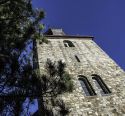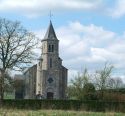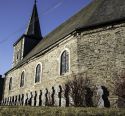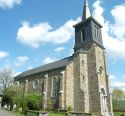The spirit of the surroundings around Lierneux
This itinerary for bike, motorcycle or car, gives pride of place to the region. It takes you through a gentle and rounded countryside. The paths invite you to wander around. But the landscape of meadows and forests that you will discover has not always been there!
Indeed, in 1830, at the birth of Belgium, the Ardennes was almost bald. Centuries of clearing have eaten the forest, transformed into charcoal to feed the forges. In its place are heather moors frequented by sheep (...)
The churches and chapels along the route are not architectural jewels from a distant past. But their simplicity, their effort to be pretty and their density on this territory are a moving testimony of rural faith.
Do not expect any scholarly discoveries, but rather let your feelings and emotions speak for themselves. Visualize the life of yesteryear. Enjoy the tranquility of the small cemeteries, barely disturbed by the sounds of the farm, the singing of birds or the wind from the peaks, in the total indifference of the cows grazing on the other side of the wall.
Course length: 38 km
Estimated time: 4h30 (bike)
This tour was designed by Anne-Cécile Hansenne, as part of a final study to become Regional Tourist Guide
Continue on PC Continue on mobile
-
Saint-André Church – Lierneux
The Saint-André de Lierneux church exudes a feeling of robustness and durability. However, this neo-Romanesque church only dates back to 1961. Indeed, time, lightning and bad weather overcame the old church, which had been severely damaged by the bombardments of the Battle of the Bulge in the winter of 1944 (...)
-
Saint-Joseph Chapel – Verleumont
The Saint-Joseph chapel in Verleumont, with its plastered facades and roof covered with wide slate scales, is one of the oldest religious buildings in the municipality of Lierneux. It dates back to 1722. Its square bell tower ends in a hexagonal structure (...)
-
Notre-Dame de la Salette Chapel – Lierneux
On the outskirts of the village, a charming white chapel watches over the war memorial. The building, dedicated to Notre-Dame de la Salette, dates from 1850. A glass door reveals the four paintings that the painter André Simar offered to the parish of his childhood (...)
-
Sainte-Walburge Church – Petit Sart
A refined church awaits you at the end of the village of Petit-Sart, on the edge of the meadows. Its wooden lattice ceiling is decorated with stencil friezes. Note the support arches, which have the same circular patterns as the side wall openings. Just as the cut-out of the rood pole railing follows the quadrilobal shape of the rose that overhangs it (...)
-
Chapelle de Pèlémont – Goronne
This charming chapel, with its harmonious proportions, stands in the middle of a grove that fills in the V formed by the crossroads. It dates back to 1854. Its benches, silence and whiteness invite you to rest and meditate.
-
Saint-Maurice Church – Arbrefontaine
In the heart of the village of Arbrefontaine, this solid neo-Romanesque building hides a delightful wooden decoration, while it jealously watches over a hundred shale crosses that have survived the disuse of the cemetery. Like the Romanesque churches of the Middle Ages, with their small windows, the church is plunged into darkness (...)
-
Calvary of Arbrefontaine
The fourteen stations of the open-air Way of the Cross are located on a hollow path bordered by trees. The path climbs, like the one Christ used to follow to reach the place of his crucifixion. An old cross from 1736 watches over the final chapel, placed on a small mound (...)
-
Notre-Dame de l'Assomption Chapel – Trou de Bra
Trou de Bra takes its name from the holes that were once dug to extract iron ore. The village is located on the banks of the river Lienne. The small river wanders joyfully in the commune of Lierneux, named after her. One of the 5,000 caves dedicated to Notre-Dame de Lourdes around the world has been open to visitors since 1912. It is surrounded by the same serpentine path as the original (...)
-
Achelîres Chapel – Bra-sur-Lienne
Below the village, in the shade of a bouquet of tall trees, is the white Chapelle des Achelîres. Disarming in its simplicity, lovingly maintained since 1750, it would be built near a site that would have hosted witches' sabbaths (...)
-
Assomption-de-la-Vierge Church – Bra-sur-Lienne
Like a big hen, the church of Bra covers the buildings for miles around. From the neighbouring farmhouse, an authentic Ardennes village life escapes. Beyond the cemetery wall, cows graze lazily, butterflies fly, chickens chatter. The massive square tower dates back to the 850s (...)
-
Saint-Monon Church – Jévigné
A stream of light happily splashes inside the church of Jévigné, which dates back to 1871. Pay attention to the multicoloured consoles that carry the statues. Their naive and neat painting, enhanced by golden details, shows a moving desire to express one's faith, with one's heart and the means at hand. The fresh painting that brightens up the church and the flowers, even artificial ones, are part of the same logic (...)






